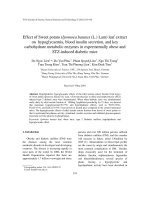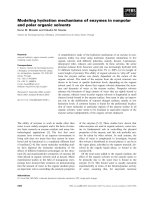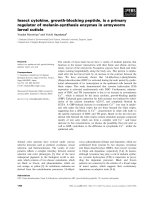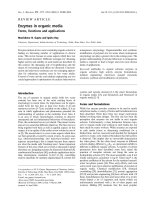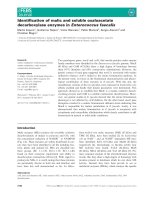enzymes in industry
Bạn đang xem bản rút gọn của tài liệu. Xem và tải ngay bản đầy đủ của tài liệu tại đây (4.85 MB, 515 trang )
Enzymes in Industry
Edited by W. Aehle
Enzymes in Industry. Wolfgang Aehle
Copyright 2004 WILEY-VCH Verlag GmbH & Co. KGaA, Weinheim
ISBN: 3-527-29592-5
Also of Interest:
Liese, A., Seelbach, K., Wandrey, C.
Industrial Biotransformations
2000
3-527-30094-5
Dunn, I. J., Heinzle, E., Ingham, J., Pr
Ï
enosil, J. E.
Biological Reaction Engineeer ing
Dynamic Modelling and Simulation
Second, Completely Revised and Extended Edition
2003
ISBN 3-527-30759-1
Bisswanger, H.
Enzyme Kinetics
Principles and Methods
2002
ISBN 3-527-30343-X
Bisswanger, H.
Practical Enzymology
2003
ISBN 3-527-30444-4
Bornscheuer, U. T. (Ed.)
Enzymes in Lipid Modification
2000
ISBN 3-527-30176-3
Enzymes in Industry
Production and Applications
Edited by Wolfgang Aehle
Dr. Wolfgang Aehle
Genencor International B. V.
PO Box 218
2300 AE Leiden
The Netherlands
&
This book was carefully produced. Nevertheless,
authors, editors, and publisher do not warrant the
information contained therein to be free of errors.
Readers are advised to keep in mind that statements,
data, illustrations, procedural details or other items
may inadvertently be inaccurate.
First Edition 1990
Second, Completely Revised Edition 2004
Library of Congress Card No.: Applied for.
British Library Cataloguing-in-Publication Data:
A catalogue record for this book is available from the
British Library
Die Deutsche Bibliothek ±
CIP Cataloguing-in-Publication-Data
A catalogue record for this publication is available
from Die Deutsche Bibliothek
2004 WILEY-VCH Verlag GmbH & Co. KGaA,
Weinheim
All rights reserved (including those of translation
into other languages). No part of this book may be
reproduced in any form ± by photoprinting,
microfilm, or any other means ± nor transmitted or
translated into a machine language without written
permission from the publishers. Registered names,
trademarks, etc. used in this book, even when not
specifically marked as such, are not to be considered
unprotected by law.
Printed in the Federal Republic of Germany.
Printed on acid-free paper.
Typesetting Kühn & Weyh, Satz und Medien,
Freiburg
Printing Strauss Offsetdruck GmbH, Mörlenbach
Bookbinding Litges & Dopf Buchbinderei GmbH,
Heppenheim
ISBN 3-527-29592-5
V
List of Contributors XV
Abbreviations XXI
1 Introduction 1
1.1 History 1
1.2 Enzyme Nomenclature 4
1.2.1 General Principles of Nomenclature 5
1.2.2 Classification and Numbering of Enzymes 6
1.3 Structure of Enzymes 7
1.3.1 Primary Structure 7
1.3.2 Three-Dimensional Structure 8
1.3.3 Quaternary Structure, Folding, and Domains 8
1.3.4 The Ribozyme 11
1.4 Biosynthesis of Enzymes 12
1.4.1 Enzymes and DNA 12
2 Catalytic Activity of Enzymes 13
2.1 Factors Governing Catalytic Activity 15
2.1.1 Temperature 15
2.1.2 Value of pH 16
2.1.3 Activation 17
2.1.4 Inhibition 17
2.1.5 Allostery 20
2.1.6 Biogenic Regulation of Activity 21
2.2 Enzyme Assays 22
2.2.1 Reaction Rate as a Measure of Catalytic Activity 22
2.2.2 Definition of Units 22
2.2.3 Absorption Photometry 23
2.2.4 Fluorometry 25
2.2.5 Luminometry 25
2.2.6 Radiometry 26
2.2.7 Potentiometry 26
Contents
Enzymes in Industry. Wolfgang Aehle
Copyright 2004 WILEY-VCH Verlag GmbH & Co. KGaA, Weinheim
ISBN: 3-527-29592-5
VI
2.2.8 Conductometry 27
2.2.9 Calorimetry 27
2.2.10 Polarimetry 27
2.2.11 Manometry 27
2.2.12 Viscosimetry 27
2.2.13 Turbidimetry 28
2.2.14 Immobilized Enzymes 28
2.2.15 Electrophoresis 28
2.3 Quality Evaluation of Enzyme Preparations 30
2.3.1 Quality Criteria 30
2.3.2 Specific Activity 30
2.3.3 Protein Determination 31
2.3.4 Contaminating Activities 32
2.3.5 Electrophoretic Purity 32
2.3.6 High-Performance Liquid Chromatography 33
2.3.7 Performance Test 33
2.3.8 Amino Acid Analysis and Protein Sequence Analysis 33
2.3.9 Stability 34
2.3.10 Formulation of Enzyme Preparations 34
3 General Production Methods 37
3.1 Microbial Production 37
3.1.1 Organism and Enzyme Synthesis 38
3.1.2 Strain Improvement 40
3.1.3 Physiological Optimization 42
3.1.4 The Fermentor and its Limitations 44
3.1.5 Process Design 46
3.1.6 Modeling and Optimization 48
3.1.7 Instrumentation and Control 49
3.2 Isolation and Purification 50
3.2.1 Preparation of Biological Starting Materials 51
3.2.1.1 Cell Disruption by Mechanical Methods 52
3.2.1.2 Cell Disruption by Nonmechanical Methods 52
3.2.2 Separation of Solid Matter 52
3.2.2.1 Filtration 52
3.2.2.2 Centrifugation 54
3.2.2.3 Extraction 56
3.2.2.4 Flocculation and Flotation 56
3.2.3 Concentration 57
3.2.3.1 Thermal Methods 57
3.2.3.2 Precipitation 57
3.2.3.3 Ultrafiltration 58
3.2.4 Purification 60
3.2.4.1 Crystallization 60
3.2.4.2 Electrophoresis 61
Contents
VII
3.2.4.3 Chromatography 61
3.2.5 Product Formulation 69
3.2.6 Waste Disposal 70
3.3 Immobilization 70
3.3.1 Definitions 71
3.3.2 History 71
3.3.3 Methods 72
3.3.3.1 Carrier Binding 73
3.3.3.2 Cross-linking 76
3.3.3.3 Entrapment 76
3.3.4 Characterization 79
3.3.5 Application 80
4 Discovery and Development of Enzymes 83
4.1 Enzyme Screening 83
4.1.1 Overview 83
4.1.2 Natural Isolate Screening 84
4.1.3 Molecular Screening 86
4.1.4 Environmental Gene Screening 87
4.1.5 Genomic Screening 89
4.1.6 Proteomic Screening 91
4.2 Protein Engineering 92
4.2.1 Introduction 92
4.2.2 Application of Protein Engineering in Academia and Industry 97
4.2.3 Outlook 100
5 Industrial Enzymes 101
5.1 Enzymes in Food Applications 101
5.1.1 Enzymes in Baking 101
5.1.1.1 Introduction 101
5.1.1.2 Amylases 102
5.1.1.3 Xylanases 107
5.1.1.4 Oxidoreductases 108
5.1.1.5 Lipases 110
5.1.1.6 Proteases 111
5.1.1.7 Transglutaminase 113
5.1.2 Enzymes in Fruit Juice Production and Fruit Processing 113
5.1.2.1 Introduction 113
5.1.2.2 Biochemistry of Fruit Cell Walls 113
5.1.2.3 Cell-Wall-Degrading Enzymes 117
5.1.2.4 Apple Processing 118
5.1.2.4.1 Apple Pulp Maceration 118
5.1.2.4.2 Apple Juice Depectinization 120
5.1.2.5 Red-Berry Processing 121
5.1.2.6 Tropical Fruit and Citrus Processing 123
Contents
5.1.2.7 Conclusion 124
5.1.3 Enzymes in Brewing 125
5.1.3.1 Introduction 125
5.1.3.2 Enzymes in Malting and Mashing 127
5.1.3.3 Enzymes for Problem Prevention or Solving 130
5.1.3.3.1 Bacterial a-Amylase in Mashing 130
5.1.3.3.2 Fungal a-Amylase in Fermentation 130
5.1.3.3.3 b-Glucanase in Mashing 131
5.1.3.3.4 Cysteine Endopeptidases (Postfermentation) 131
5.1.3.3.5 Glucoamylase in Mashing 131
5.1.3.4 Enzymes for Process Improvement 132
5.1.3.4.1 Adjunct Brewing 132
5.1.3.4.2 Improved Mashing Processes 133
5.1.3.4.3 Shelf-Life Improvement 134
5.1.3.4.4 Accelerated Maturation 135
5.1.3.4.5 Starch-Haze Removal 135
5.1.3.5 Special Brewing Processes 136
5.1.4 Enzymes in Dairy Applications 136
5.1.4.1 Introduction 136
5.1.4.2 Cheesemaking 137
5.1.4.2.1 Cheesemaking Process 137
5.1.4.2.2 Mechanism of Renneting 137
5.1.4.2.3 Types of Coagulants 137
5.1.4.2.4 Properties of Coagulating Enzymes 138
5.1.4.2.5 Cheese Ripening 140
5.1.4.2.6 Cheese Flavors and Ripening Acceleration 141
5.1.4.2.7 Lipase 141
5.1.4.2.8 Lysozyme 142
5.1.4.2.9 Milk Protein Hydrolysates 143
5.1.4.2.10 Transglutaminase 143
5.1.4.3 Milk Processing 143
5.1.4.3.1 b-Galactosidase 143
5.1.4.3.2 Other Enzymes 145
5.1.5 Other Food Applications 145
5.1.5.1 Introduction 145
5.1.5.2 Meat and Fish 145
5.1.5.2.1 Meat Processing 145
5.1.5.2.2 Fish Processing 146
5.1.5.3 Protein Cross-linking 147
5.1.5.4 Flavor Development 148
5.1.5.4.1 Protein Hydrolysis 148
5.1.5.4.2 Lipid Hydrolysis 149
5.1.5.5 Egg Powder 150
5.1.5.6 Oils and Fats 151
5.1.5.6.1 Fat Splitting 151
ContentsVIII
5.1.5.6.2 Interesterification 152
5.1.5.6.3 Esterification 154
5.1.5.6.4 Oil Degumming 155
5.2 Enzymes in Nonfood Applications 155
5.2.1 Enzymes in Household Detergents 155
5.2.1.1 Historical Development 155
5.2.1.2 Laundry Soils 157
5.2.1.3 Detergent Composition and Washing Process 159
5.2.1.3.1 Washing Process 159
5.2.1.3.2 Detergent Compositions 159
5.2.1.4 Enzyme-Aided Detergency and Soil Removal 161
5.2.1.5 Detergent Enzyme Performance Evaluation and Screening 161
5.2.1.6 Enzyme Types 165
5.2.1.6.1 Proteases 165
5.2.1.6.2 Amylases 169
5.2.1.6.3 Lipases 172
5.2.1.6.4 Cellulases 175
5.2.1.6.5 Mannanase 177
5.2.1.7 Future Trends 178
5.2.2 Enzymes in Automatic Dishwashing 180
5.2.2.1 Introduction 180
5.2.2.2 Characteristics of Enzymes for ADDs 181
5.2.2.3 Proteases 182
5.2.2.3.1 Proteins: The Substrate of Proteases 182
5.2.2.3.2 Proteases for ADDs 182
5.2.2.4 Amylases 184
5.2.2.4.1 Starch: The Substrate of Amylases 184
5.2.2.4.2 Amylases for ADDs 185
5.2.2.5 Other Enzymes 187
5.2.2.6 Automatic Dishwashing Detergents 187
5.2.2.6.1 Composition of Automatic Dishwashing Detergents 188
5.2.2.6.2 Application of Enzymes in ADD 189
5.2.2.6.3 Stability and Compatibility 194
5.2.3 Enzymes in Grain Wet-Milling 194
5.2.3.1 Introduction 194
5.2.3.2 Overview of the Conversion of Corn to HFCS 194
5.2.3.2.1 Corn Steeping 196
5.2.3.2.2 Coarse Grinding and Germ Removal by Cyclone Separation 197
5.2.3.2.3 Fine Grinding and Fiber Removal by Screening 197
5.2.3.2.4 Centrifugation and Washing to Separate Starch from Protein 197
5.2.3.2.5 Hydrolysis with a-Amylase (Liquefaction) 197
5.2.3.2.6 Hydrolysis with Glucoamylase (Saccharification) 198
5.2.3.2.7 Isomerization with Glucose Isomerase 198
5.2.3.2.8 Fructose Enrichment and Blending 199
5.2.3.3 a-Amylase 199
Contents IX
5.2.3.3.1 Origin and Enzymatic Properties 199
5.2.3.3.2 Structure 200
5.2.3.3.3 Industrial Use 202
5.2.3.4 Glucoamylase 202
5.2.3.4.1 Origin and Enzymatic Properties 202
5.2.3.4.2 Structure 203
5.2.3.4.3 Industrial Use 204
5.2.3.5 Pullulanase 205
5.2.3.5.1 Origin and Enzymatic Properties 205
5.2.3.5.2 Structure 205
5.2.3.5.3 Industrial Use 206
5.2.3.6 Glucose Isomerase 206
5.2.3.6.1 Origin and Enzymatic Properties 206
5.2.3.6.2 Structure 207
5.2.3.6.3 Industrial Use of Glucose Isomerase 208
5.2.3.7 Use of Wheat Starch 209
5.2.4 Enzymes in Animal Feeds 210
5.2.4.1 Introduction 210
5.2.4.2 Enzymes Used in Animal Feed 211
5.2.4.2.1 Fiber-Degrading Enzymes 211
5.2.4.2.2 Phytic Acid Degrading Enzymes (Phytases) 215
5.2.4.2.3 Protein-Degrading Enzymes (Proteases) 216
5.2.4.2.4 Starch-Degrading Enzymes (Amylases) 217
5.2.4.3 Future Developments 218
5.2.5 Enzymes in Textile Production 219
5.2.5.1 Introduction 219
5.2.5.2 Cellulose Fibers 220
5.2.5.2.1 Desizing of Cotton Cellulose Fibers 220
5.2.5.2.2 Scouring of Cotton 221
5.2.5.2.3 Bleaching of Cotton 221
5.2.5.2.4 Removal of Hydrogen Peroxide 222
5.2.5.2.5 Cotton Finishing 222
5.2.5.2.6 Ageing of Denim 224
5.2.5.2.7 Processing of Man-Made Cellulose Fibers 225
5.2.5.2.8 Processing of Bast Fibers 226
5.2.5.3 Proteinous Fibers 226
5.2.5.3.1 Wool Processing 226
5.2.5.3.2 Degumming of Silk 228
5.2.5.4 Textile Effluent Treatment and Recycling 229
5.2.5.5 Outlook 231
5.2.6 Enzymes in Pulp and Paper Processing 232
5.2.6.1 Introduction 232
5.2.6.2 Enzymes 233
5.2.6.2.1 Cellulases 234
5.2.6.2.2 Hemicellulases 234
ContentsX
5.2.6.2.3 Lignin-Modifying, Oxidative Enzymes 236
5.2.6.3 Enzymes in Pulp and Paper Processing 238
5.2.6.3.1 Mechanical Pulping 238
5.2.6.3.2 Chemical Pulping 239
5.2.6.3.3 Bleaching 240
5.2.6.3.4 Papermaking 242
5.2.6.3.5 Deinking 244
5.3 Development of New Industrial Enzyme Applications 244
5.3.1 Introduction 244
5.3.2 Enzymes in Cosmetics 246
5.3.2.1 Hair Dyeing 247
5.3.2.1.1 Oxidases 248
5.3.2.1.2 Peroxidases 249
5.3.2.1.3 Polyphenol Oxidases 249
5.3.2.2 Hair Waving 250
5.3.2.3 Skin Care 250
5.3.2.4 Toothpastes and Mouthwashes 251
5.3.2.5 Enzymes in Cleaning of Artificial Dentures 252
5.3.3 Enzymes for Preservation 252
5.3.4 Enzymes in Hard-Surface Cleaning 253
5.3.4.1 Enzymes in Membrane Cleaning 253
5.3.4.1.1 Proteases 253
5.3.4.1.2 Hemicellulases 254
5.3.5 Enzymes Generating a pH Shift 254
5.3.6 Enzymes in Cork Treatment 255
5.3.7 Enzymes in Oil-Field Applications 256
5.3.8 Enzymes in Wastewater Treatment 256
5.3.9 Enzymes for Polymerisation: Wood Fiberboard Production 257
5.4 Overview of Industrial Enzyme Applications 257
6 Nonindustrial Enzyme Usage 263
6.1 Enzymes in Organic Synthesis 263
6.1.1 Introduction 263
6.1.2 Examples of Enzymatic Conversions 264
6.1.2.1 Syntheses by Means of Hydrolases 264
6.1.2.2 Reduction of CÐO and CÐC Bonds 268
6.1.2.3 Oxidation of Alcohols and Oxygenation of CÐH and CÐC Bonds 269
6.1.2.4 CÐC Coupling 271
6.1.2.5 Formation of Glycosidic Bonds 272
6.1.2.6 Enzymatic Protecting Proup Techniques 274
6.1.3 Enzyme-Analogous Catalysts 276
6.1.4 Commercial Applications 278
6.1.4.1 General 278
6.1.4.2 Nonstereoselective Biocatalytic Reactions 280
6.1.4.3 Biocatalytic Resolution Processes 281
Contents XI
6.1.4.3.1 Enzymatic Acylation of Amino Groups 286
6.1.4.3.2 Enzymatic Hydrolysis of Hydantoins 287
6.1.4.3.3 Enzymatic Hydrolysis of Lactams 289
6.1.4.3.4 Enzymatic Hydrolysis of CÐO Bonds 290
6.1.4.3.5 Enzymatic Hydrolysis of Nitriles 291
6.1.4.3.6 Enzymatic Cleavage of threo Aldol Products 292
6.1.4.4 Biocatalytic Asymmetric Synthesis 292
6.1.4.4.1 Biocatalytic Reductive Amination of CÐO Bonds 293
6.1.4.4.2 Biocatalytic Hydrocyanation of CÐO Bonds 294
6.1.4.4.3 Biocatalytic Addition of Water to CÐO Bonds 294
6.1.4.4.4 Biocatalytic Amination of CÐC Bonds 294
6.1.5 Outlook 295
6.2 Therapeutic Enzymes 295
6.2.1 Requirements for the Use of Enzymes in Therapy 295
6.2.2 Coping with Peculiar Protein Properties 296
6.2.3 Sources of Enzymes and Production Systems 299
6.2.4 Overview of Therapeutic Enzymes 300
6.2.4.1 Oxidoreductases 305
6.2.4.2 Transferases 306
6.2.4.3 Esterases 307
6.2.4.4 Nucleases 307
6.2.4.5 Glycosidases 308
6.2.4.6 Proteases 310
6.2.4.6.1 Pancreatic and Gastric Proteases 310
6.2.4.6.2 Plasma Proteases 310
6.2.4.6.3 Coagulation Factors 311
6.2.4.6.4 Plasminogen Activators 313
6.2.4.6.5 Proteases from Snake Venoms 315
6.2.4.6.6 Plant and Microbial Proteases 316
6.2.4.7 Amidases 316
6.2.4.8 Lyases 317
6.3 Enzymes in Diagnosis 317
6.3.1 Determination of Substrate Concentration 318
6.3.2 Determination of Enzyme Activity 319
6.3.3 Immunoassays 320
6.4 Enzymes for Food Analysis 322
6.4.1 Carbohydrates 323
6.4.2 Organic Acids 326
6.4.3 Alcohols 330
6.4.4 Other Food Ingredients 332
6.5 Enzymes in Genetic Engineering 334
6.5.1 Restriction Endonucleases and Methylases 337
6.5.1.1 Classification 337
6.5.1.2 Activity of Class II Restriction Endonucleases 347
6.5.1.2.1 Reaction Parameters 347
ContentsXII
6.5.1.2.2 Additional Structural Requirements Influencing Activity 348
6.5.1.3 Specificity of Class II Restriction Endonucleases 349
6.5.1.3.1 Palindromic Recognition Sequences 349
6.5.1.3.2 Nonpalindromic Recognition Sequences 352
6.5.1.3.3 Isoschizomers 352
6.5.1.4 Changes in Sequence Specificity 353
6.5.1.5 Novel Class II Restriction Endonucleases 355
6.5.2 DNA Polymerases 356
6.5.2.1 Escherichia coli DNA Polymerase I 356
6.5.2.2 Klenow Enzyme 358
6.5.2.3 T4 DNA Polymerase 360
6.5.2.4 Reverse Transcriptase 361
6.5.2.5 Terminal Transferase 363
6.5.3 RNA Polymerases 363
6.5.3.1 SP6 RNA Polymerase 363
6.5.3.2 T7 RNA Polymerase 365
6.5.4 DNA Nucleases 366
6.5.4.1 DNase I 367
6.5.4.2 Exonuclease III 367
6.5.4.3 Nuclease S1 368
6.5.4.4 Nuclease Bal 31 369
6.5.5 RNA Nucleases 370
6.5.5.1 RNase H 370
6.5.5.2 Site-Specific RNases 371
6.5.5.2.1 RNase A 371
6.5.5.2.2 RNase CL3 371
6.5.5.2.3 RNase T
1
Ribonuclease T
1
372
6.5.5.2.4 RNase U
2
Ribonuclease U
2
372
6.5.5.2.5 Nuclease S7 372
6.5.5.2.6 Site-Specific RNases in RNA Sequence Analysis 373
6.5.6 Modifying Enzymes 377
6.5.6.1 Alkaline Phosphatase 378
6.5.6.2 T4 DNA Ligase 393
6.5.6.3 Escherichia coli DNA Ligase 394
6.5.6.4 T4 Polynucleotide Kinase 395
6.5.6.5 T4 Polynucleotide Kinase, 3¢-Phosphatase-Free 397
6.5.6.6 Methylase HpaII 397
7 Enzyme Safety and Regulatory Considerations 399
7.1 Safe Handling of Enzymes 399
7.1.1 Possible Health Effects 400
7.1.2 Control Technology 400
7.2 Product Regulatory Considerations 403
7.2.1 Food-Use Enzymes 404
7.2.2 Feed-Use Enzymes 408
Contents XIII
7.2.3 Industrial-Use Enzymes 410
References 413
Index 465
ContentsXIV
Editor
Dr. Wolfgang Aehle
Genencor International B. V.
Research & Development
P.O. Box 218
2300 AE Leiden
The Netherlands
Authors
Dr. Wolfgang Aehle
Genencor International B. V.
Research & Development
P.O. Box 218
2300 AE Leiden
The Netherlands
Chapter 1, Sections 4.2, 5.4
Dr. Richard L. Antrim
Grain Processing Corporation
1600 Oregon Street
Muscatine, IA 52761-1494
USA
Section 5.2.3
Todd Becker
Genencor International, Inc.
925 Page Mill Road
Palo Alto, CA 94304-1013
USA
Section 3.2.5
Dr. Rick Bott
Genencor International, Inc.
925 Page Mill Road
Palo Alto, CA 94304-1013
USA
Section 4.2
Dr. Johanna Buchert
VTT Biotechnology
P.O. Box 1500
2044 VTT
Finland
Section 5.2.6
Dr. Heidi Burrows
Finfeeds International
P.O. Box 777
Wiltshire, SN8 1XN Marlborough
UK
Section 5.2.4
Alice J. Caddow
Genencor International Inc.
925 Page Mill Road
Palo Alto, CA 94304-1013
USA
Chapter 7
Dr. Gopal K. Chotani
Genencor International, Inc.
925 Page Mill Road
Palo Alto, CA 94304-1013
USA
Section 3.1
XV
List of Contributors
Enzymes in Industry. Wolfgang Aehle
Copyright 2004 WILEY-VCH Verlag GmbH & Co. KGaA, Weinheim
ISBN: 3-527-29592-5
Beth Concoby
Genencor International Inc.
925 Page Mill Road
Palo Alto, CA 94304-1013
USA
Chapter 7
Dr. Hans de Nobel
Genencor International B. V.
Research & Development
P.O. Box 218
2300 AE Leiden
The Netherlands
Section 4.1
Dr. AndrØ de Roos
DSM Food Specialities
P.O. Box 1
2600 MA Delft
The Netherlands
Section 5.1.4
Dr. Carlo Dinkel
SiChem GmbH
BITZ
Fahrenheitstr. 1
28359 Bremen
Germany
Section 6.1
Timothy C. Dodge
Genencor International, Inc.
925 Page Mill Road
Palo Alto, CA 94304-1013
USA
Section 3.1
Prof. Dr. Karlheinz Drauz
Degussa AG
Fine Chemicals
Rodenbacher ChaussØe 4
63457 Hanau-Wolfgang
Germany
Section 6.1
Prof. Dr. Saburo Fukui ²
formerly Department of
Industrial Chemistry
Faculty of Engineering
Kyoto University
606-8501 Kyoto
Japan
Section 3.3
Dr. Christian Gölker
Bayer AG
Aprather Weg
42096 Wuppertal
Germany
Section 3.2
Dr. Catherine Grassin
DSM Food Specialties
15, rue des Comtesses
P.O. Box 239
59472 Seclin Cedex
France
Section 5.1.2
Dr. Harald Gröger
Degussa AG
Project House Biotechnology
Rodenbacher ChaussØe 4
63457 Hanau-Wolfgang
Germany
Section 6.1
Dr. Meng H. Heng
Genencor International, Inc.
925 Page Mill Road
Palo Alto, CA 94304-1013
USA
Sections 3.2.2.4, 3.2.4.1
Dr. Günther Henniger
formerly Roche Diagnostics GmbH
Nonnenwald 2
82377 Penzberg
Germany
Section 6.4
List of ContributorsXVI
Dr. Ivan Herbots
Procter & Gamble Eurocor S.A.
Temselaan 100
1853 Strombeek-Bever
Belgium
Section 5.2.1
Dr. Marga Herweijer
DSM Food Specialties
Research and Development
P.O. Box 1
2600 MA Delft
The Netherlands
Section 5.1.2
Dr. Brian Jones
Genencor International B. V.
Research & Development
P.O. Box 218
2300 AE Leiden
The Netherlands
Section 4.1
Dr. Albert Jonke
Roche Diagnostics GmbH
Nonnenwald 2
82377 Penzberg
Germany
Chapter 2
John Kan
Genencor International, Inc.
925 Page Mill Road
Palo Alto, CA 94304-1013
USA
Sections 3.2.2.4, 3.2.4.1
Dr. Christoph Kessler
Roche Diagnostics GmbH
Nonnenwald 2
82377 Penzberg
Germany
Section 6.5
Dr. Beatrix Kottwitz
R&D / Technology Laundry and
Home Care
Henkel KGaA
Henkelstr. 67
40191 Düsseldorf
Germany
Section 5.2.2
Dr. Karsten M. Kragh
Danisco A/S
Edwin Rahrs Vej 38
8220 Brabrand
Denmark
Section 5.1.1
Dr. Georg-Burkhard Kresse
Roche Diagnostics GmbH
Pharma Research / Biology
Nonnenwald 2
82377 Penzberg
Germany
Section 6.2
Dr. Herman B. M. Lenting
TNO Industry
Centre for Textile Research
P.O. Box 337
7500 AH Enschede
The Netherlands
Section 5.2.5
Dr. Karl-Heinz Maurer
Henkel KGaA
Department of Enzyme Technology
Henkelstr. 67
40191 Düsseldorf
Germany
Section 5.3
List of Contributors XVII
Dr. Gerhard Michal
formerly Boehringer Mannheim
GmbH
Research
68298 Mannheim
Germany
Chapter 2
Dr. Marja-Leena Niku-Paavola
VTT Biotechnology
P.O. Box 1500
2044 VTT
Finland
Section 5.2.6
Prof. Dr. Richard N. Perham
University of Cambridge
Department of Biochemistry
80 Tennis Court Road
CB2 1GA Cambridge
England
Chapter 1
Dr. Charlotte Horsmans Poulsen
Danisco A/S
Edwin Rahrs Vej 38
8220 Brabrand
Denmark
Section 5.1.1
Prof. Dr. Peter J. Reilly
Iowa State University
Department of Chemical Engineering
2114 Sweeney Hall
Ames, IA 50011-2230
USA
Section 5.2.3
Dr. Andrea Saettler
Henkel KGaA
Department of Enzyme Technology
Henkelstr. 67
40191 Düsseldorf
Germany
Section 5.3
Dr. Rainer Schmuck
Roche Diagnostics GmbH
Diagnostic Research
Nonnenwald 2
82377 Penzberg
Germany
Section 6.3
Dr. Carsten Schultz
EMBL
Meyerhofstr. 1
69117 Heidelberg
Germany
Section 6.1
Dr. Jorn Borch Soe
Danisco A/S
Edwin Rahrs Vej 38
8220 Brabrand
Denmark
Section 5.1.5
Jens Frisback Sorensen
Danisco A/S
Edwin Rahrs Vej 38
8220 Brabrand
Denmark
Section 5.1.1
Dr. Anna Suurnäkki
VTT Biotechnology
P.O. Box 1500
2044 VTT
Finland
Section 5.2.6
Prof. Dr. Atsuo Tanaka
Department of Industrial Chemistry
Faculty of Engineering
Kyoto University
606-8501 Kyoto
Japan
Section 3.3
List of ContributorsXVIII
Dr. Andreas Herman
Terwisscha van Scheltinga
DSM-Gist Research and Development
Alexander Fleminglaan 1
2613 AX Delft
The Netherlands
Section 3.1
Dr. Liisa Viikari
VTT Biotechnology
P.O. Box 1500
2044 VTT
Finland
Section 5.2.6
Prof. Dr. Herbert Waldmann
Max-Planck-Institut für molekulare
Physiologie
Otto-Hahn-Str. 11
44227 Dortmund
Germany
Section 6.1
Dr. Jan Wilms
Antonine der Kinderen
Rietschoot 179
1511 WG Oostzaan
The Netherlands
Section 5.1.3
Dr. Karl Wulff
Boeringer Mannheim GmbH
Bahnhofsstr. 9-15
82327 Tutzing
Germany
Section 6.3
List of Contributors XIX
XXI
A: adenosine
ACA: acetamidocinnamic acid
ACL: a-amino-e-aprolactam
ADH: alcohol dehydrogenase
ADI: acceptable daily intake
ADP: adenosine 5¢-diphosphate
Ala: alanine
Arg: arginine
AMP: adenosine 5¢-monophosphate
ATC: d,l-2-amino-D
2
-thiazoline-4-carboxylic acid
ATP: adenosine 5¢-triphosphate
C: cytidine
cDNA: copy DNA
CL: citrate lyase
CMP: cytidine 5¢-monophosphate
CoA: coenzyme A
CS: citrate synthetase
CTP: cytidine 5¢-triphosphate
d: deoxy
dam: gene locus for E. coli DNA adenine methylase (N
6
-methyladenine)
dcmI: gene locus for E. coli DNA cytosine methylase(5-methylcytosine)
dd: dideoxy
ddNTP: dideoxynucleoside 5¢-triphosphate
DE: dextrose equivalent
DEAE: diethylaminoethyl
DNA: deoxyribonucleic acid
DNase: deoxyribonuclease
dNTP: deoxynucleoside 5¢-triphosphate
DOPA: 3-(3,4-dihydroxyphenylalanine) [3-hydroxy-l-tyrosine]
dpm: decays per minute
ds: double-stranded
Abbreviations
Enzymes in Industry. Wolfgang Aehle
Copyright 2004 WILEY-VCH Verlag GmbH & Co. KGaA, Weinheim
ISBN: 3-527-29592-5
XXII
E.C.: Enzyme Commission
F6P: fructose 6-phosphate
FAN: free alpha amino nitrogen, i.e., a measure of peptides/amino acids
available for yeast to be used as nutrient
fMet: N-formylmethionine
FMN: flavin mononucleotide
FMNH
2
: flavin mononucleotide, reduced
G: guanosine
GDP: guanosine 5¢-diphosphate
Glu: glutamic acid
Gly: glycine
GMP: guanosine 5¢-monophosphate
GOD: glucose oxidase
GOT: glutamate oxaloacetate transaminase
G6P: glucose 6-phosphate
GPT: glutamate pyruvate transaminase
GTP: guanosine 5¢-triphosphate
3-HBDH: 3-hydroxybutyrate dehydrogenase
HFCS: high-fructose corn syrup
hsdM: E. coli gene locus for methylation
hsdR: E. coli gene locus for restriction
hsdS: E. coli gene locus for sequence specificity
IDP: inosine 5¢-diphosphate
Ile: isoleucine
INT: iodonitrotetrazolium chloride
ITP: inosine 5¢-triphosphate
LDH: lactate dehydrogenase
Lys: lysine
m(superscript): methylated
MDH: malate dehydrogenase
Met: methionine
M6P: mannose 6-phosphate
mRNA: messenger RNA
MTT: 3-(4,5-dimethylthiazolyl-2)-2,5-diphenyltetrazolium bromide
N: any nucleotide
NAD: nicotinamide ± adenine dinucleotide
NADH: nicotinamide ± adenine dinucleotide, reduced
NADP: nicotinamide ± adenine dinucleotide phosphate
Abbreviations
XXIII
NADPH: nicotinamide ± adenine dinucleotide phosphate, reduced
NMN: nicotinamide mononucleotide
NTP: nucleoside 5¢-triphosphate
p: phosphate groups
32
P: phosphate groups containing
32
P phosphorus atoms
p
i
: inorganic phosphate
P: degree Plato; i.e., sugar content equivalent to 1 % sucrose by weight
PEP: phosphoenolpyruvate
6-PGDH: 6-phosphogluconate dehydrogenase
Phe: phenylalanine
PMS: 5-methylphenazinium methyl sulfate
poly(dA): poly(deoxyadenosine 5¢-monophosphate)
ppi: inorganic pyrophosphate
Pro: proline
PRPP: phosphoribosyl pyrophosphate
Pu: purine
Py: pyrimidine
r: ribo
RNA: ribonucleic acid
RNase: ribonuclease
SAM: S-adenosylmethionine
SMHT: serine hydroxymethyltransferase
ss: single-stranded
T: thymidine
TMP: thymidine 5¢-monophosphate
tRNA: transfer RNA
TTP: thymidine 5¢-triphosphate
U: uridine
UMP: uridine 5¢-monophosphate
UTP: uridine 5¢-triphosphate
Val: valine
Plasmids:
pBR322
pBR328
pSM1
pSP64
pSP65
pSPT18, pSPT19
Abbreviations
pT7±1, pT7±2
pUC 18, pUC 19
pUR222
Bacteriophages:
fd
ghl
M13
N4
PBS1
PBS2
SPO1
SP6
SP15
T3
T4
T5
T7
XP12
gt11
SM11
X174
Eukaryotic viruses:
Ad2
SV40
AbbreviationsXXIV
1
Enzymes are the catalysts of biological processes. Like any other catalyst, an enzyme
brings the reaction catalyzed to its equilibrium position more quickly than would
occur otherwise; an enzyme cannot bring about a reaction with an unfavorable
change in free energy unless that reaction can be coupled to one whose free energy
change is more favorable. This situation is not uncommon in biological systems,
but the true role of the enzymes involved should not be mistaken.
The activities of enzymes have been recognized for thousands of years; the fer-
mentation of sugar to alcohol by yeast is among the earliest examples of a biotechno-
logical process. However, only recently have the properties of enzymes been under-
stood properly. Indeed, research on enzymes has now entered a new phase with the
fusion of ideas from protein chemistry, molecular biophysics, and molecular biol-
ogy. Full accounts of the chemistry of enzymes, their structure, kinetics, and techno-
logical potential can be found in many books and series devoted to these topics
[1±5]. This chapter reviews some aspects of the history of enzymes, their nomencla-
ture, their structure, and their relationship to recent developments in molecular
biology.
1.1
History
Detailed histories of the study of enzymes can be found in the literature [6], [7].
Early Concepts of Enzymes. The term ªenzymeº (literally ªin yeastº) was coined by
Kühne in 1876. Yeast, because of the acknowledged importance of fermentation,
was a popular subject of research. A major controversy at that time, associated most
memorably with Liebig and Pasteur, was whether or not the process of fermenta-
tion was separable from the living cell. No belief in the necessity of vital forces, how-
ever, survived the demonstration by Buchner (1897) that alcoholic fermentation
could by carried out by a cell-free yeast extract. The existence of extracellular
enzymes had, for reasons of experimental accessibility, already been recognized. For
example, as early as 1783, Spallanzani had demonstrated that gastric juice could
digest meat in vitro, and Schwann (1836) called the active substance pepsin.
1
Introduction
Enzymes in Industry. Wolfgang Aehle
Copyright 2004 WILEY-VCH Verlag GmbH & Co. KGaA, Weinheim
ISBN: 3-527-29592-5
